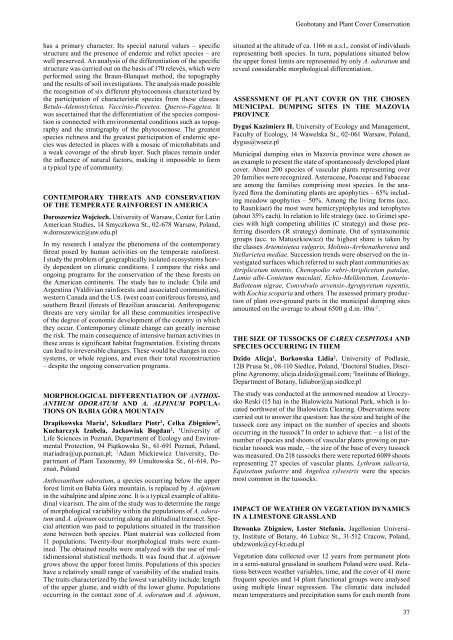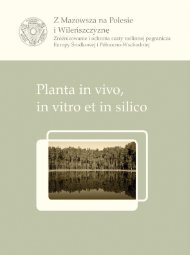acta societatis botanicorum poloniae - LV Zjazd Polskiego ...
acta societatis botanicorum poloniae - LV Zjazd Polskiego ...
acta societatis botanicorum poloniae - LV Zjazd Polskiego ...
You also want an ePaper? Increase the reach of your titles
YUMPU automatically turns print PDFs into web optimized ePapers that Google loves.
has a primary character. Its special natural values – specific<br />
structure and the presence of endemic and relict species – are<br />
well preserved. An analysis of the differentiation of the specific<br />
structure was carried out on the basis of 170 relevés, which were<br />
performed using the Braun-Blanquet method, the topography<br />
and the results of soil investigations. The analysis made possible<br />
the recognition of six different phytocoenosis characterized by<br />
the participation of characteristic species from these classes:<br />
Betulo-Adenostyletea, Vaccinio-Piceetea, Querco-Fagetea. It<br />
was ascertained that the differentiation of the species composition<br />
is connected with environmental conditions such as topography<br />
and the stratigraphy of the phytocoenose. The greatest<br />
species richness and the greatest participation of endemic species<br />
was detected in places with a mosaic of microhabitats and<br />
a weak covorage of the shrub layer. Such places remain under<br />
the influence of natural factors, making it impossible to form<br />
a typical type of community.<br />
CONTEMPOrArY THrEATS ANd CONSErVATION<br />
OF THE TEMPErATE rAINFOrEST IN AMErICA<br />
doroszewicz Wojciech. University of Warsaw, Center for Latin<br />
American Studies, 14 Smyczkowa St., 02-678 Warsaw, Poland,<br />
w.doroszewicz@uw.edu.pl<br />
In my research I analyze the phenomena of the contemporary<br />
threat posed by human activities on the temperate rainforest.<br />
I study the problem of geographically isolated ecosystems heavily<br />
dependent on climatic conditions. I compare the risks and<br />
ongoing programs for the conservation of the these forests on<br />
the American continents. The study has to include: Chile and<br />
Argentina (Valdivian rainforests and associated communities),<br />
western Canada and the U.S. (west coast coniferous forests), and<br />
southern Brazil (forests of Brazilian araucaria). Anthropogenic<br />
threats are very similar for all these communities irrespective<br />
of the degree of economic development of the country in which<br />
they occur. Contemporary climate change can greatly increase<br />
the risk. The main consequence of intensive human activities in<br />
these areas is significant habitat fragmentation. Existing threats<br />
can lead to irreversible changes. These would be changes in ecosystems,<br />
or whole regions, and even their total reconstruction<br />
– despite the ongoing conservation programs.<br />
MOrPHOLOGICAL dIFFErENTIATION OF Anthox-<br />
Anthum odorAtum ANd A. AlPinum POPULAtIoNS<br />
oN BABIA GóRA MoUNtAIN<br />
drapikowska Maria 1 , Szkudlarz Piotr 2 , Celka Zbigniew 2 ,<br />
Kucharczyk Izabela, Jackowiak Bogdan 2 . 1 University of<br />
Life Sciences in Poznań, Department of Ecology and Environmental<br />
Protection, 94 Piątkowska St., 61-691 Poznań, Poland,<br />
mariadra@up.poznan.pl; 2 Adam Mickiewicz University, Department<br />
of Plant Taxonomy, 89 Umultowska St., 61-614, Poznań,<br />
Poland<br />
Anthoxanthum odoratum, a species occurring below the upper<br />
forest limit on Babia Góra mountain, is replaced by A. alpinum<br />
in the subalpine and alpine zone. It is a typical example of altitudinal<br />
vicarism. The aim of the study was to determine the range<br />
of morphological variability within the populations of A. odoratum<br />
and A. alpinum occurring along an altitudinal transect. Special<br />
attention was paid to populations situated in the transition<br />
zone between both species. Plant material was collected from<br />
11 populations. Twenty-four morphological traits were examined.<br />
The obtained results were analyzed with the use of multidimensional<br />
statistical methods. It was found that A. alpinum<br />
grows above the upper forest limits. Populations of this species<br />
have a relatively small range of variability of the studied traits.<br />
The traits characterized by the lowest variability include: length<br />
of the upper glume, and width of the lower glume. Populations<br />
occurring in the contact zone of A. odoratum and A. alpinum,<br />
Geobotany and Plant Cover Conservation<br />
situated at the altitude of ca. 1166 m a.s.l., consist of individuals<br />
representing both species. In turn, populations situated below<br />
the upper forest limits are represented by only A. odoratum and<br />
reveal considerable morphological differentiation.<br />
ASSESSMENT OF PLANT COVEr ON THE CHOSEN<br />
MUNICIPAL dUMPING SITES IN THE MAZOVIA<br />
PrOVINCE<br />
Dyguś Kazimierz H. University of Ecology and Management,<br />
Faculty of Ecology, 14 Wawelska St., 02-061 Warsaw, Poland,<br />
dygus@wseiz.pl<br />
Municipal dumping sites in Mazovia province were chosen as<br />
an example to present the state of spontaneously developed plant<br />
cover. About 200 species of vascular plants representing over<br />
20 families were recognized. Asteraceae, Poaceae and Fabaceae<br />
are among the families comprising most species. In the analyzed<br />
flora the dominating plants are apophyties – 65% including<br />
meadow apophyties – 50%. Among the living forms (acc.<br />
to Raunkiaer) the most were hemicryptophytes and terophytes<br />
(about 35% each). In relation to life strategy (acc. to Grime) species<br />
with high competing abilities (C strategy) and those preferring<br />
disorders (R strategy) dominate. Out of syntaxonomic<br />
groups (acc. to Matuszkiewicz) the highest share is taken by<br />
the classes Artemisietea vulgaris, Molinio-Arrhenatheretea and<br />
Stellarietea mediae. Succession trends were observed on the investigated<br />
surfaces which referred to such plant communities as:<br />
Atriplicetum nitentis, Chenopodio rubri-Atriplicetum patulae,<br />
Lamio albi-Conietum maculati, Echio-Melilotetum, Leonurio-<br />
Balloteum nigrae, Convolvulo arvensis-Agropyretum repentis,<br />
with Kochia scoparia and others. The assessed primary production<br />
of plant over-ground parts in the municipal dumping sites<br />
amounted on the average to about 6500 g d.m.·10m -2 .<br />
THE SIZE OF TUSSOCKS OF cArex cesPitosA ANd<br />
SPECIES OCCUrrING IN THEM<br />
dzido Alicja1 , Borkowska Lidia2 . University of Podlasie,<br />
12B Prusa St., 08-110 Siedlce, Poland, 1Doctoral Studies, Discipline<br />
Agronomy, alicja.dzido@gmail.com; 2Institute of Biology,<br />
Department of Botany, lidiabor@ap.siedlce.pl<br />
The study was conducted at the unmowned meadow at Uroczysko<br />
Reski (15 ha) in the Białowieża National Park, which is located<br />
northwest of the Bialowieża Clearing. Observations were<br />
carried out to answer the question: has the size and height of the<br />
tussock core any impact on the number of species and shoots<br />
occurring in the tussock? In order to achieve that: – a list of the<br />
number of species and shoots of vascular plants growing on particular<br />
tussock was made, – the size of the base of every tussock<br />
was measured. On 218 tussocks there were reported 6089 shoots<br />
representing 27 species of vascular plants. Lythrum salicaria,<br />
Equisetum palustre and Angelica sylvestris were the species<br />
most common in the tussocks.<br />
IMPACT OF WEATHEr ON VEGETATION dYNAMICS<br />
IN A LIMESTONE GrASSLANd<br />
dzwonko Zbigniew, Loster Stefania. Jagellonian University,<br />
Institute of Botany, 46 Lubicz St., 31-512 Cracow, Poland,<br />
ubdzwonk@cyf-kr.edu.pl<br />
Vegetation data collected over 12 years from permanent plots<br />
in a semi-natural grassland in southern Poland were used. Relations<br />
between weather variables, time, and the cover of 41 more<br />
frequent species and 14 plant functional groups were analysed<br />
using multiple linear regression. The climatic data included<br />
mean temperatures and precipitation sums for each month from<br />
37



